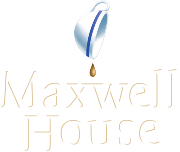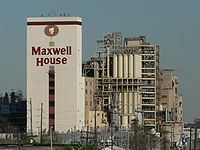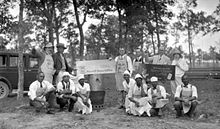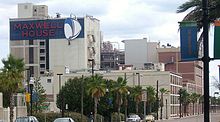- Maxwell House
-
Maxwell House 
Type Subsidiary Industry Beverage Founded 1892 Headquarters Houston, Texas, U.S. Parent Kraft Foods Website www.kraftbrands.com/maxwellhousecoffee  Former Maxwell House factory located in Houston, Texas
Former Maxwell House factory located in Houston, Texas
Maxwell House is a brand of coffee manufactured by a like-named division of Kraft Foods. Introduced in 1892, it is named in honor of the Maxwell House Hotel in Nashville, Tennessee. For many years until the late 1980s it was the largest-selling coffee in the U.S. and is currently (ca. 2007) second behind Folgers, which is manufactured by The J.M. Smucker Co. The company recently unveiled a new slogan, "Good Just Got Great," visible on their website. However, it is best known for its longtime slogan, "Good to the last drop," and is still running ads featuring the line.
Contents
"Good to the last drop"
In 1917, Cheek-Neal began using a "Good to the Last Drop" slogan to advertise their Maxwell House Coffee. For several years, the ads made no mention of Theodore Roosevelt as the phrase's originator. By the 1930s, however, the company was running advertisements that claimed that the former President had taken a sip of Maxwell House Coffee on a visit to Andrew Jackson's estate, The Hermitage, near Nashville on October 21, 1907 and that when served coffee he had proclaimed it to be "Good to the Last Drop."[1] During this time, Coca-Cola also used the slogan "Good to the last drop".[2] In modern times, Maxwell House has distanced itself from its own original claim stating that the slogan was actually written by Clifford Spiller, former president of General Foods Corporation, and did not come from a Roosevelt remark overheard by Cheek-Neal. The phrase remains a registered trademark for the product and appears on its logo. While the veracity of the Roosevelt relation to the phrase has never been historically established in the press of local papers that covered Roosevelt's October 21 visit and one of his coffee drinking episodes, without doubt, the Maxwell House Company, itself, for many years, claimed in its own advertising that the Roosevelt story was true.[3] In 2009, Maxwell House ran a commercial with Roosevelt repriser, Joe Wiegand telling the "Last Drop" story. [4] The Theodore Roosevelt Association, an organization dedicated to preserving Roosevelt's history and heritage, has paper evidence backing up the story. [5]
Expansion of the product line
In 1942 General Foods Corporation, the successor to the Postum Company, began supplying instant coffee to the U.S. armed forces. Beginning in the fall of 1945 this product, now branded as Maxwell House Instant Coffee, entered test markets in the eastern U.S. and began national distribution the following year.
In 1966 the company introduced "Maxwell House ElectraPerk", developed specifically for electric percolators.
In 1969, General Foods in the UK launched granulated coffee. They used a pantomime stage format in the London Hilton for a show called "Once Upon a Coffee Time". In this story the weak "Prince of Powdah" and his mentor "Reschem" travel the world in search of blends. Meeting and falling in love with "Princess Purity", and fighting the dragon "Old Hat", the young man emerges as"Prince Granulo", heir to the Kingdom of Maxwell. This show was written by Michael Ingrams, produced by the Mitchell Monkhouse Agency and designed by Malcolm Lewis and Chris Miles of Media.
In 1976 the product was joined by "Maxwell House A.D.C." coffee, the name reflecting its intended use in automatic drip coffee makers such as Mr. Coffee, which were in the process of pushing aside traditional coffee-preparation methods. In 1972 the company had introduced "Max-Pax" ground coffee filter rings, aimed at the then still-strong market for drip coffee preparation. Although this method, too, has been eclipsed, the Max-Pax concept was subsequently adapted as Maxwell House Filter Packs (1989) for use in automatic coffee makers. By the 1990s formulations for specific preparation methods had been quietly discontinued. The brand is now marketed in ground and pre-measured forms, as well as in whole-bean, flavored and varietal blends.[3] A higher-yield ground coffee, "Maxwell House Master Blend," was introduced in 1981 and "Rich French Roast," "Colombian Supreme," and "1892," a "slow-roasted" formulation, in 1989. In recent years the names of these products have been modified by the company to present a more "uniform" Maxwell House brand image.
Decaffeinated coffee
Although General Foods had been marketing decaffeinated coffee under various brand names ("Sanka" since 1927 and "Brim" and "Maxim," the latter a freeze-dried instant coffee, since the 1950s), it refrained from actually selling Maxwell House-labeled decaffeinated coffee products until 1983, when it introduced ground "Maxwell House Decaffeinated" into east-coast markets. (At the same time, a decaffeinated version of its long-established, lighter-tasting "Yuban" brand was introduced on the west coast.) "Maxwell House Instant Decaffeinated Coffee" finally hit the shelves in 1985. A further modification of the decaf theme, "Maxwell House Lite," a "reduced-caffeine" blend, was introduced nationally in 1992 and its instant form the following year.
Advertising
During the 1920s the Maxwell House brand began to be extensively advertised across the US. Total advertising expenditure rose from $19,955 in 1921 to $276,894 in 1924, and consequently the brand was cited as the most well-known coffee brand in a 1925 study of consumer goods.[6]
Maxwell House was the sponsor of Maxwell House Coffee Time, better known as The Burns and Allen Show. Each episode began with Gracie Allen saying "Another cup of Maxwell House coffee, George?" George Burns would always reply "Sure. Pour me a cup, Gracie." Allen would continue "You know, Maxwell House is always good to the last... drop." "And that drop's good too.", Burns would reply. It also featured many comedic advertisements with Bill Goodwin. Maxwell House also sponsored Molly Goldberg on radio and later on television.
Maxwell House was also the sponsor of the radio version of Father Knows Best. Each episode began with the youngest daughter Kitten asking, "Mother, is Maxwell House really the best coffee in the whole world?" to which her mother would reply, "Well, your father says so, and Father Knows Best!" It was later replaced by Postum, a hot decaffeinated beverage that was touted by Father as being a calming beverage that wouldn't keep you up or make you jittery.
Maxwell House was the long-time sponsor of the early television series, Mama, based on the play and film I Remember Mama. It starred Peggy Wood as the matriarch of a Norwegian-American family. It ran on the CBS network from 1949 to 1957 and was perhaps the first example of product placement on a TV show, as the family frequently gathered around the kitchen table for a cup of Maxwell House coffee, though these segments, aired towards the end of each episode, were usually kept separate from the main storyline. Early television programs were frequently packaged by the advertising agencies of individual sponsors. As this practice became less common in the late 1950s, Maxwell House, like most national brands, turned to "spot" advertising, with the agencies creating sometimes long-running campaigns in support of their products. One such 1970s campaign for Maxwell House featured the actress Margaret Hamilton, the former wicked witch in The Wizard of Oz, as Cora, the general store owner who proudly announced that Maxwell House was the only brand she sold. Maxwell House was also a well-known sponsor of the Burns and Allen radio show, during which Maxwell House spots were incorporated into the plots of the actual radio scripts.
Along with television advertising, Maxwell House used various print campaigns, always featuring the tagline "good to the last drop." The publication of its Passover haggadah by the Joseph Jacobs Advertising Agency beginning in 1932[7] made Maxwell House a household name with many American Jewish families. This was a clever marketing strategy by owner Joseph Jacobs, who hired an Orthodox rabbi to certify that the coffee bean was technically more like a berry than a bean and, consequently, kosher for Passover. Maxwell House coffee was the first to target a Jewish demographic, and the haggadah continues to represent a synthesis of American and Jewish interests. It was also reportedly used for the first Seder held at the White House in 2009, and again in 2011, by Barack Obama.[8][9]
Manufacturing facilities
Maxwell House coffee is still produced at two U.S. locations: Jacksonville, Florida, and San Leandro, California. A third plant (the oldest of the group, and the largest in the world at the time), located in Hoboken, New Jersey, was closed in the early 1990s. Its enormous rooftop sign, proclaiming the brand name and a dripping coffee cup, was a landmark visible in New York City across the Hudson River from Manhattan. The plant was later sold and demolished. The site, like most New Jersey riverfront property opposite Manhattan, is now occupied by a condominium. The plant was divested by Kraft Foods to Maximus Coffee Group LP in late 2006. In March 2007, the neon coffee cup sign which glowed like a beacon over the city's East End was removed from atop the side of the sixteen-story coffee roaster building. The same fate befell the Houston plant, at one time the second largest plant in the world; it's huge iconic sign had been visible from Downtown Houston, The University of Houston Campus, the Ship Channel, and to everyone who passed through Houston, on either I-45, or I-10. It was one of the first sites of a major Sanka, decafenation plant, and later one of the world's largest Maxin plants, producing freeze dried coffee. The original main plant that housed the traditional M.R.G. section, [mixing, roasting, grinding, and packaging], [and the huge Minute Rice Plant, was once a Ford Assembly Plant. Maxwell house Coffee Company, and the rest of General Foods Corp., were among first large scale manufacturers in The South, and Nationally, to be peaceably, and successfully integrate their entire work force. Oldvet13 (talk) 06:37, 22 October 2011 (UTC) Oldvet13.
See also
References
- ^ TNhistoryforkids.org See link with 1930s Maxwell House "TR" advertisement
- ^ Library of Congress
- ^ TNhistoryforkids.org See link with 1930s Maxwell House "TR" advertisement
- ^ http://www.youtube.com/watch?v=jLmVPufCd1w Joe Wiegand Portrays Theodore Roosevelt in Maxwell House Commercial
- ^ http://www.theodoreroosevelt.org Theodore Roosevelt Association
- ^ George B. Hotchkiss and Richard B. Franken, The Measurement of Advertising Effects (NY: Harper and Brothers, 1927), p. 174.
- ^ http://www.nytimes.com/2011/04/09/nyregion/09haggadah.html?_r=2&hp
- ^ WritesLikeSheTalks.com
- ^ haaretz.com
External links
- MaxwellHouse.com
- Kraft.com, Joel Cheek biography at Kraft Foods
- Maxwell House Hagaddah and Joseph Jacobs Advertising
Kraft Foods brands Nabisco
and other snacksArrowroot · Barnum's Animals · Better Cheddars · Cheese Nips · Cameo · Chips Ahoy! · Claussen · Club Social · Corn Nuts · Fig Newton · Filipinos · Fudgee-O · Ginger Snaps · Handi-Snacks · Honey Maid · In a Biskit · Jell-O · Lefèvre-Utile (LU) · Lorna Doone · Mallomars · Nilla · Nutter Butter · Oreo · Peek Freans · Planters · Premium Crackers · Ritz Crackers · SnackWells · Sociables · Social Tea · Teddy Grahams · Triscuit · Vegetable Thins · Wheatsworth · Wheat Thins
Cadbury Bassett's · Boost · Bournville · Bournvita · Brunch Bar · Buttons · Caramilk · Cherry Ripe · Chomp · Clusters · Creme Egg1 · Creme Egg Twisted · Crunchie · Curly Wurly · Dairy Milk (Caramel)1 · Double Decker · Dream (chocolate) · Fingers · Flake · Freddo · Fry's · Fudge · Green & Black's · Heroes · Kent · Kréma · Koko · La Pie qui Chante · Maynards · Milk Tray · Mini Eggs · Moro · Mr. Big · Old Gold · Pascall · Picnic · Poulain · Roses · Shots · Snack · Star Bar · The Natural Confectionery Company · Time Out · Trebor · Turkish Delight · Twirl · Vichy Pastilles · Wispa
Cadbury Adams
and other gumBubbaloo · Bubblicious · Certs · Chiclets · Clorets · Dentyne · Halls · Hollywood · Malabar · Stimorol · Stride · Sour Patch Kids · Swedish Fish · Trident
Other confectionery Alpen Gold · Baker's Chocolate · Côte d'Or · Daim · Freia · Jet-Puffed · Kvikk Lunsj · Lacta · Marabou · Milka · Prince Polo · Terry's · Toblerone · Trakinas
Condiments A1 Steak Sauce · Bonox · Bull's-Eye Barbecue Sauce · Grey Poupon · Kraft Mayo · Miracle Whip · Vegemite
Coffee
and other beveragesCafé HAG · Capri Sun2 · Carte Noire · Country Time · Crystal Light · General Foods International · Gevalia · Grand'Mère · Jacobs · Kenco · Kool-Aid · Maxwell House · Nabob · Onko · Sanka · Tang · Tassimo · Yuban
Cheese
and dairy productsCheez Whiz · Cool Whip · Cracker Barrel · Dairylea · Easy Cheese · Philadelphia · Polly-O · Provel cheese · Singles · Velveeta
Convenience foods
and baking goodsBagel-fuls · Boca Burger · Calumet · Good Seasons · Kraft Macaroni and Cheese · Lunchables · Oscar Mayer · Royal · Shake 'n Bake · Simmenthal · South Beach Living · Stove Top · Sure-Jell
1In the United States, these products are marketed by The Hershey Company (but made by Kraft's Cadbury subsidiary) under a prior licensing agreement.
2This brand is owned by Rudolf Wild GmbH and manufactured under license by Kraft Foods only in the United States, Canada, and Greenland.
Ticker: NYSE: KFT · Kraft Foods Corporate · Kraft Media CenterCategories:- Coffee brands
- Kraft Foods brands
- 1892 introductions
Wikimedia Foundation. 2010.



